Sustainable Engineering & Logistic: Building Project in London
VerifiedAdded on 2023/06/15
|12
|3955
|123
Report
AI Summary
This report analyzes a building project in London from an environmental sustainability perspective. It identifies environmental, social, and economic issues impacting the project's cost and timeline. The report explores the use of renewable energy sources like solar and wind power, agro-waste construction materials, recyclable concrete and timber. It also discusses supply chain management, procurement processes, and health & safety factors during production, emphasizing risk assessment and prevention. The report highlights the necessity of active and passive design systems for the project and their potential impact, aiming for a sustainable and efficient construction process.
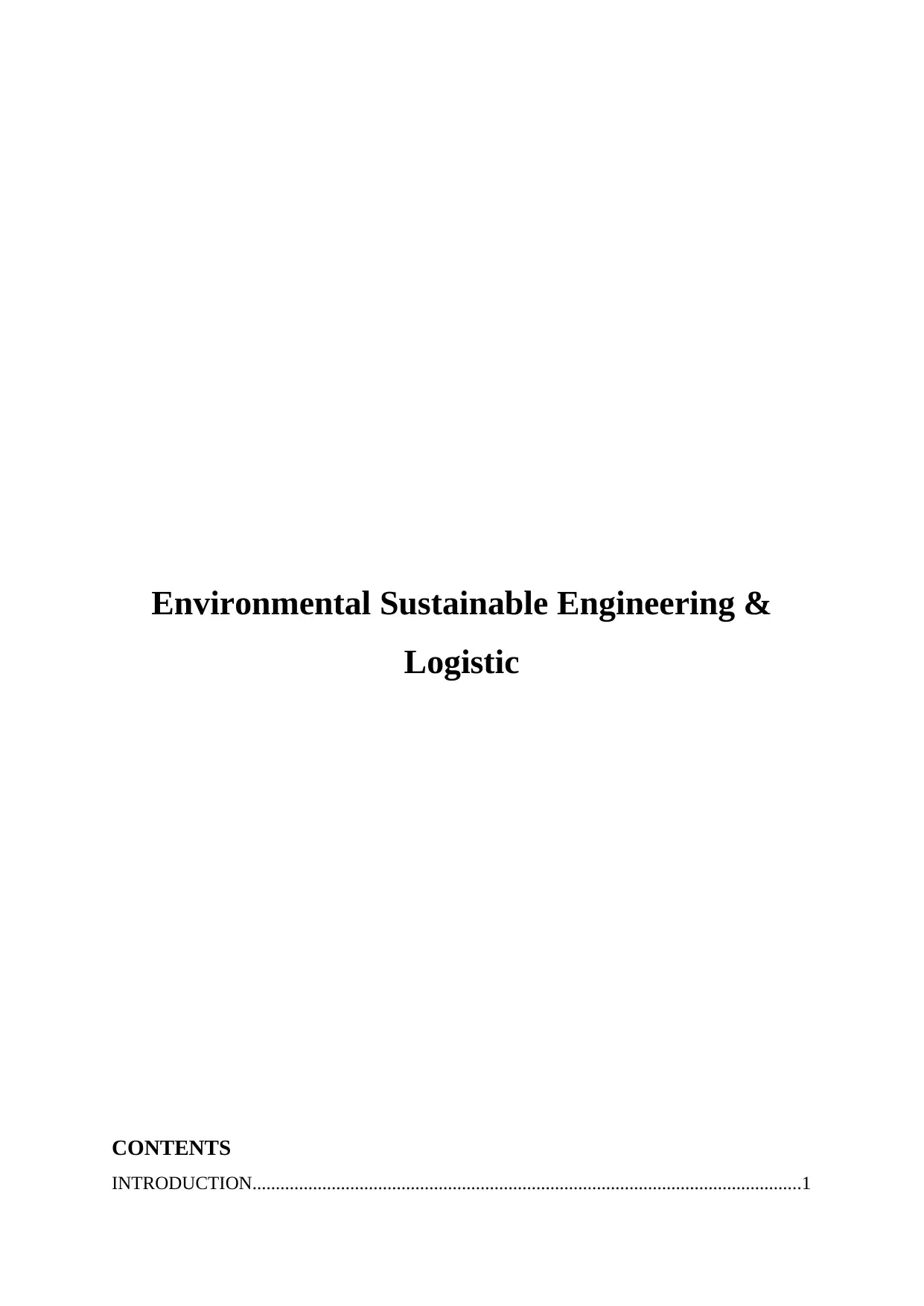
Environmental Sustainable Engineering &
Logistic
CONTENTS
INTRODUCTION......................................................................................................................1
Logistic
CONTENTS
INTRODUCTION......................................................................................................................1
Paraphrase This Document
Need a fresh take? Get an instant paraphrase of this document with our AI Paraphraser
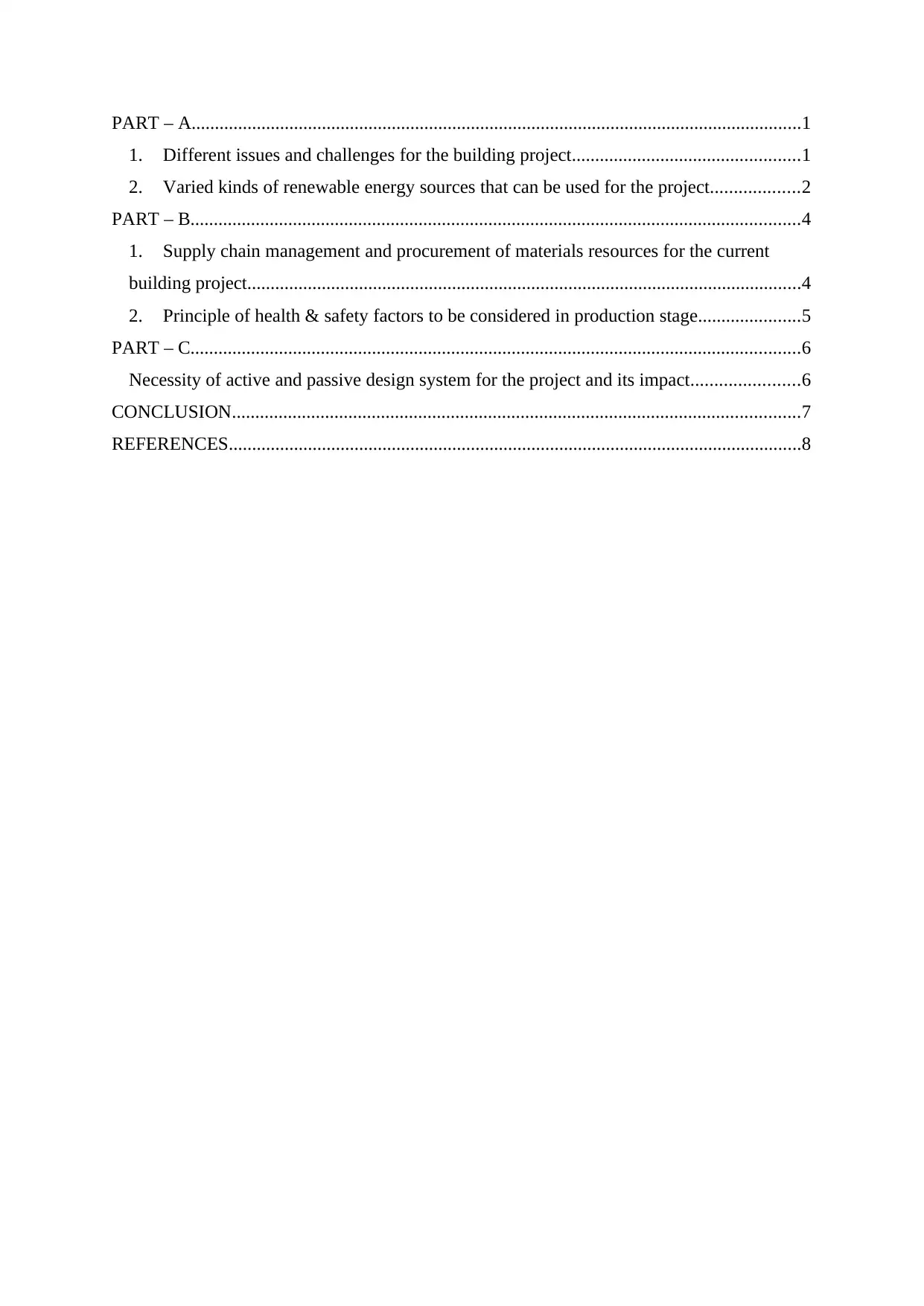
PART – A...................................................................................................................................1
1. Different issues and challenges for the building project.................................................1
2. Varied kinds of renewable energy sources that can be used for the project...................2
PART – B...................................................................................................................................4
1. Supply chain management and procurement of materials resources for the current
building project.......................................................................................................................4
2. Principle of health & safety factors to be considered in production stage......................5
PART – C...................................................................................................................................6
Necessity of active and passive design system for the project and its impact.......................6
CONCLUSION..........................................................................................................................7
REFERENCES...........................................................................................................................8
1. Different issues and challenges for the building project.................................................1
2. Varied kinds of renewable energy sources that can be used for the project...................2
PART – B...................................................................................................................................4
1. Supply chain management and procurement of materials resources for the current
building project.......................................................................................................................4
2. Principle of health & safety factors to be considered in production stage......................5
PART – C...................................................................................................................................6
Necessity of active and passive design system for the project and its impact.......................6
CONCLUSION..........................................................................................................................7
REFERENCES...........................................................................................................................8
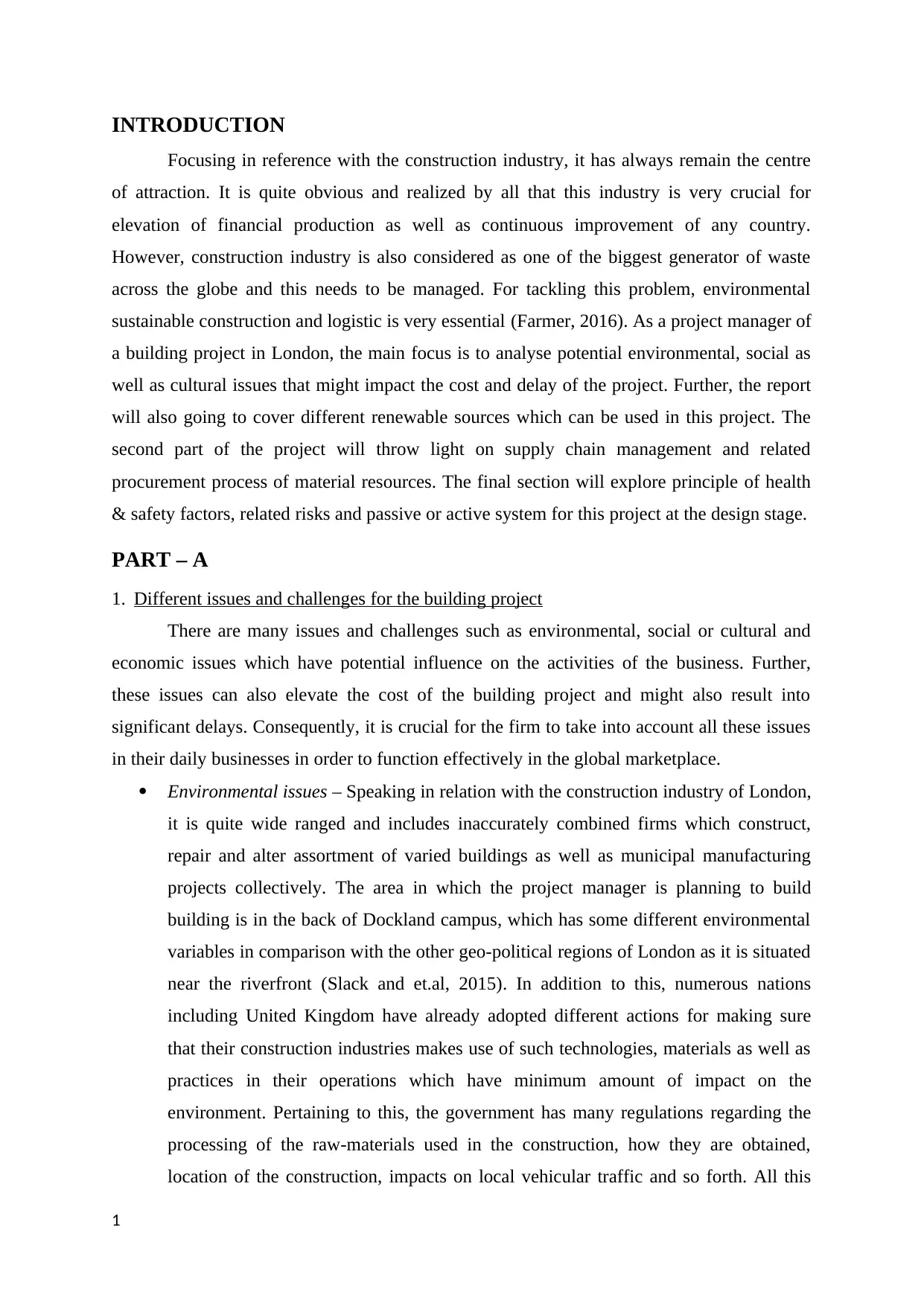
INTRODUCTION
Focusing in reference with the construction industry, it has always remain the centre
of attraction. It is quite obvious and realized by all that this industry is very crucial for
elevation of financial production as well as continuous improvement of any country.
However, construction industry is also considered as one of the biggest generator of waste
across the globe and this needs to be managed. For tackling this problem, environmental
sustainable construction and logistic is very essential (Farmer, 2016). As a project manager of
a building project in London, the main focus is to analyse potential environmental, social as
well as cultural issues that might impact the cost and delay of the project. Further, the report
will also going to cover different renewable sources which can be used in this project. The
second part of the project will throw light on supply chain management and related
procurement process of material resources. The final section will explore principle of health
& safety factors, related risks and passive or active system for this project at the design stage.
PART – A
1. Different issues and challenges for the building project
There are many issues and challenges such as environmental, social or cultural and
economic issues which have potential influence on the activities of the business. Further,
these issues can also elevate the cost of the building project and might also result into
significant delays. Consequently, it is crucial for the firm to take into account all these issues
in their daily businesses in order to function effectively in the global marketplace.
Environmental issues – Speaking in relation with the construction industry of London,
it is quite wide ranged and includes inaccurately combined firms which construct,
repair and alter assortment of varied buildings as well as municipal manufacturing
projects collectively. The area in which the project manager is planning to build
building is in the back of Dockland campus, which has some different environmental
variables in comparison with the other geo-political regions of London as it is situated
near the riverfront (Slack and et.al, 2015). In addition to this, numerous nations
including United Kingdom have already adopted different actions for making sure
that their construction industries makes use of such technologies, materials as well as
practices in their operations which have minimum amount of impact on the
environment. Pertaining to this, the government has many regulations regarding the
processing of the raw-materials used in the construction, how they are obtained,
location of the construction, impacts on local vehicular traffic and so forth. All this
1
Focusing in reference with the construction industry, it has always remain the centre
of attraction. It is quite obvious and realized by all that this industry is very crucial for
elevation of financial production as well as continuous improvement of any country.
However, construction industry is also considered as one of the biggest generator of waste
across the globe and this needs to be managed. For tackling this problem, environmental
sustainable construction and logistic is very essential (Farmer, 2016). As a project manager of
a building project in London, the main focus is to analyse potential environmental, social as
well as cultural issues that might impact the cost and delay of the project. Further, the report
will also going to cover different renewable sources which can be used in this project. The
second part of the project will throw light on supply chain management and related
procurement process of material resources. The final section will explore principle of health
& safety factors, related risks and passive or active system for this project at the design stage.
PART – A
1. Different issues and challenges for the building project
There are many issues and challenges such as environmental, social or cultural and
economic issues which have potential influence on the activities of the business. Further,
these issues can also elevate the cost of the building project and might also result into
significant delays. Consequently, it is crucial for the firm to take into account all these issues
in their daily businesses in order to function effectively in the global marketplace.
Environmental issues – Speaking in relation with the construction industry of London,
it is quite wide ranged and includes inaccurately combined firms which construct,
repair and alter assortment of varied buildings as well as municipal manufacturing
projects collectively. The area in which the project manager is planning to build
building is in the back of Dockland campus, which has some different environmental
variables in comparison with the other geo-political regions of London as it is situated
near the riverfront (Slack and et.al, 2015). In addition to this, numerous nations
including United Kingdom have already adopted different actions for making sure
that their construction industries makes use of such technologies, materials as well as
practices in their operations which have minimum amount of impact on the
environment. Pertaining to this, the government has many regulations regarding the
processing of the raw-materials used in the construction, how they are obtained,
location of the construction, impacts on local vehicular traffic and so forth. All this
1
⊘ This is a preview!⊘
Do you want full access?
Subscribe today to unlock all pages.

Trusted by 1+ million students worldwide
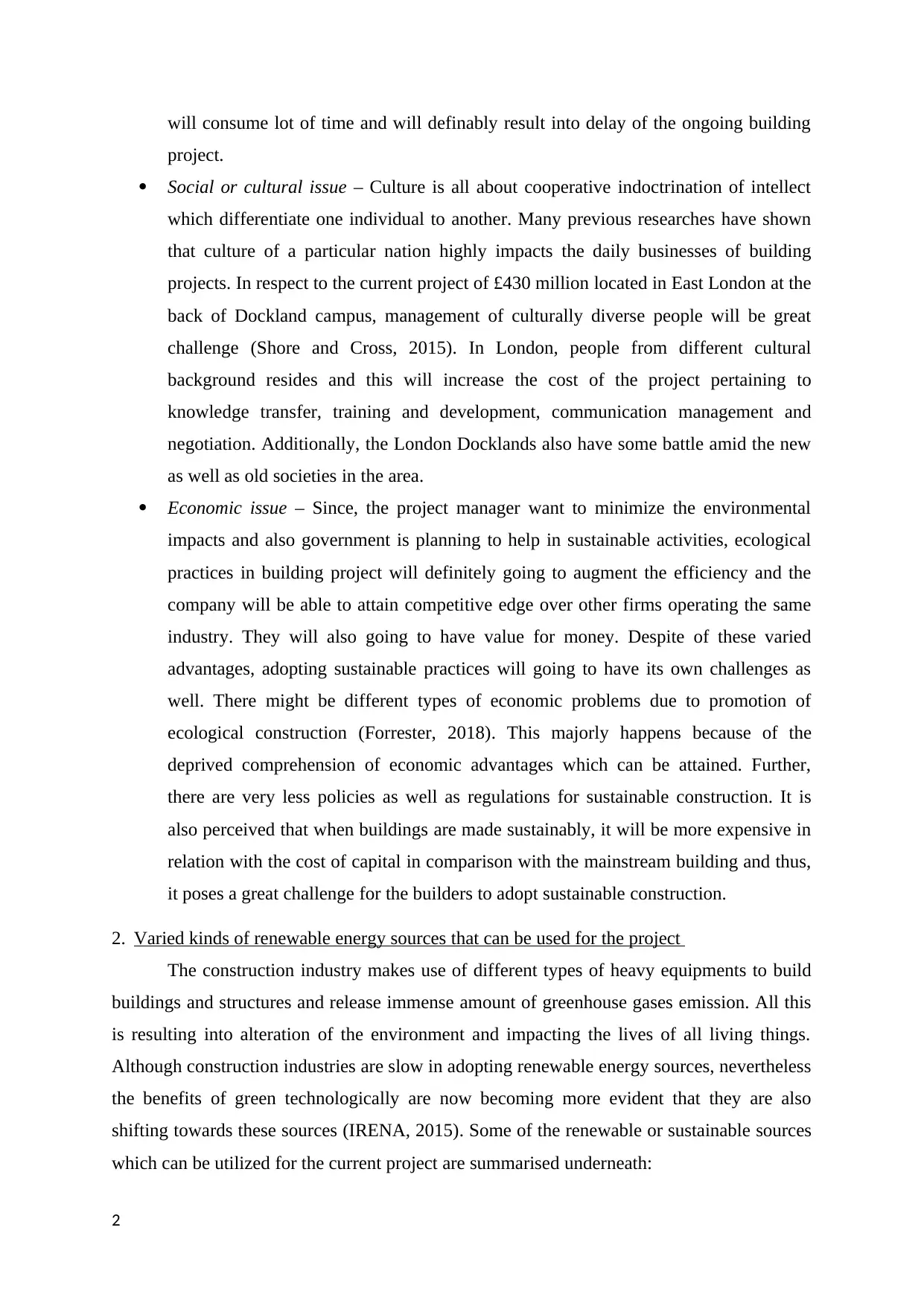
will consume lot of time and will definably result into delay of the ongoing building
project.
Social or cultural issue – Culture is all about cooperative indoctrination of intellect
which differentiate one individual to another. Many previous researches have shown
that culture of a particular nation highly impacts the daily businesses of building
projects. In respect to the current project of £430 million located in East London at the
back of Dockland campus, management of culturally diverse people will be great
challenge (Shore and Cross, 2015). In London, people from different cultural
background resides and this will increase the cost of the project pertaining to
knowledge transfer, training and development, communication management and
negotiation. Additionally, the London Docklands also have some battle amid the new
as well as old societies in the area.
Economic issue – Since, the project manager want to minimize the environmental
impacts and also government is planning to help in sustainable activities, ecological
practices in building project will definitely going to augment the efficiency and the
company will be able to attain competitive edge over other firms operating the same
industry. They will also going to have value for money. Despite of these varied
advantages, adopting sustainable practices will going to have its own challenges as
well. There might be different types of economic problems due to promotion of
ecological construction (Forrester, 2018). This majorly happens because of the
deprived comprehension of economic advantages which can be attained. Further,
there are very less policies as well as regulations for sustainable construction. It is
also perceived that when buildings are made sustainably, it will be more expensive in
relation with the cost of capital in comparison with the mainstream building and thus,
it poses a great challenge for the builders to adopt sustainable construction.
2. Varied kinds of renewable energy sources that can be used for the project
The construction industry makes use of different types of heavy equipments to build
buildings and structures and release immense amount of greenhouse gases emission. All this
is resulting into alteration of the environment and impacting the lives of all living things.
Although construction industries are slow in adopting renewable energy sources, nevertheless
the benefits of green technologically are now becoming more evident that they are also
shifting towards these sources (IRENA, 2015). Some of the renewable or sustainable sources
which can be utilized for the current project are summarised underneath:
2
project.
Social or cultural issue – Culture is all about cooperative indoctrination of intellect
which differentiate one individual to another. Many previous researches have shown
that culture of a particular nation highly impacts the daily businesses of building
projects. In respect to the current project of £430 million located in East London at the
back of Dockland campus, management of culturally diverse people will be great
challenge (Shore and Cross, 2015). In London, people from different cultural
background resides and this will increase the cost of the project pertaining to
knowledge transfer, training and development, communication management and
negotiation. Additionally, the London Docklands also have some battle amid the new
as well as old societies in the area.
Economic issue – Since, the project manager want to minimize the environmental
impacts and also government is planning to help in sustainable activities, ecological
practices in building project will definitely going to augment the efficiency and the
company will be able to attain competitive edge over other firms operating the same
industry. They will also going to have value for money. Despite of these varied
advantages, adopting sustainable practices will going to have its own challenges as
well. There might be different types of economic problems due to promotion of
ecological construction (Forrester, 2018). This majorly happens because of the
deprived comprehension of economic advantages which can be attained. Further,
there are very less policies as well as regulations for sustainable construction. It is
also perceived that when buildings are made sustainably, it will be more expensive in
relation with the cost of capital in comparison with the mainstream building and thus,
it poses a great challenge for the builders to adopt sustainable construction.
2. Varied kinds of renewable energy sources that can be used for the project
The construction industry makes use of different types of heavy equipments to build
buildings and structures and release immense amount of greenhouse gases emission. All this
is resulting into alteration of the environment and impacting the lives of all living things.
Although construction industries are slow in adopting renewable energy sources, nevertheless
the benefits of green technologically are now becoming more evident that they are also
shifting towards these sources (IRENA, 2015). Some of the renewable or sustainable sources
which can be utilized for the current project are summarised underneath:
2
Paraphrase This Document
Need a fresh take? Get an instant paraphrase of this document with our AI Paraphraser
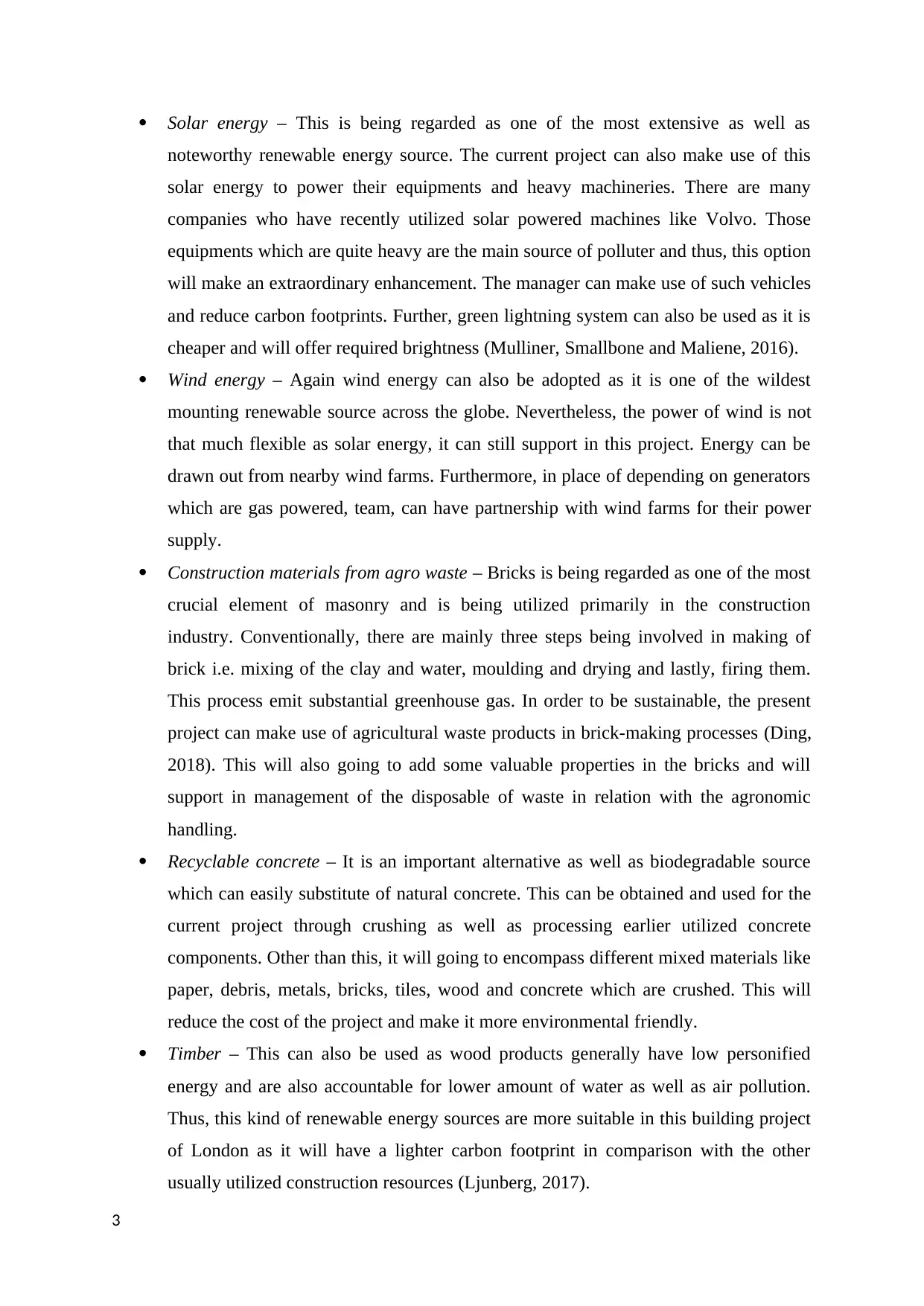
Solar energy – This is being regarded as one of the most extensive as well as
noteworthy renewable energy source. The current project can also make use of this
solar energy to power their equipments and heavy machineries. There are many
companies who have recently utilized solar powered machines like Volvo. Those
equipments which are quite heavy are the main source of polluter and thus, this option
will make an extraordinary enhancement. The manager can make use of such vehicles
and reduce carbon footprints. Further, green lightning system can also be used as it is
cheaper and will offer required brightness (Mulliner, Smallbone and Maliene, 2016).
Wind energy – Again wind energy can also be adopted as it is one of the wildest
mounting renewable source across the globe. Nevertheless, the power of wind is not
that much flexible as solar energy, it can still support in this project. Energy can be
drawn out from nearby wind farms. Furthermore, in place of depending on generators
which are gas powered, team, can have partnership with wind farms for their power
supply.
Construction materials from agro waste – Bricks is being regarded as one of the most
crucial element of masonry and is being utilized primarily in the construction
industry. Conventionally, there are mainly three steps being involved in making of
brick i.e. mixing of the clay and water, moulding and drying and lastly, firing them.
This process emit substantial greenhouse gas. In order to be sustainable, the present
project can make use of agricultural waste products in brick-making processes (Ding,
2018). This will also going to add some valuable properties in the bricks and will
support in management of the disposable of waste in relation with the agronomic
handling.
Recyclable concrete – It is an important alternative as well as biodegradable source
which can easily substitute of natural concrete. This can be obtained and used for the
current project through crushing as well as processing earlier utilized concrete
components. Other than this, it will going to encompass different mixed materials like
paper, debris, metals, bricks, tiles, wood and concrete which are crushed. This will
reduce the cost of the project and make it more environmental friendly.
Timber – This can also be used as wood products generally have low personified
energy and are also accountable for lower amount of water as well as air pollution.
Thus, this kind of renewable energy sources are more suitable in this building project
of London as it will have a lighter carbon footprint in comparison with the other
usually utilized construction resources (Ljunberg, 2017).
3
noteworthy renewable energy source. The current project can also make use of this
solar energy to power their equipments and heavy machineries. There are many
companies who have recently utilized solar powered machines like Volvo. Those
equipments which are quite heavy are the main source of polluter and thus, this option
will make an extraordinary enhancement. The manager can make use of such vehicles
and reduce carbon footprints. Further, green lightning system can also be used as it is
cheaper and will offer required brightness (Mulliner, Smallbone and Maliene, 2016).
Wind energy – Again wind energy can also be adopted as it is one of the wildest
mounting renewable source across the globe. Nevertheless, the power of wind is not
that much flexible as solar energy, it can still support in this project. Energy can be
drawn out from nearby wind farms. Furthermore, in place of depending on generators
which are gas powered, team, can have partnership with wind farms for their power
supply.
Construction materials from agro waste – Bricks is being regarded as one of the most
crucial element of masonry and is being utilized primarily in the construction
industry. Conventionally, there are mainly three steps being involved in making of
brick i.e. mixing of the clay and water, moulding and drying and lastly, firing them.
This process emit substantial greenhouse gas. In order to be sustainable, the present
project can make use of agricultural waste products in brick-making processes (Ding,
2018). This will also going to add some valuable properties in the bricks and will
support in management of the disposable of waste in relation with the agronomic
handling.
Recyclable concrete – It is an important alternative as well as biodegradable source
which can easily substitute of natural concrete. This can be obtained and used for the
current project through crushing as well as processing earlier utilized concrete
components. Other than this, it will going to encompass different mixed materials like
paper, debris, metals, bricks, tiles, wood and concrete which are crushed. This will
reduce the cost of the project and make it more environmental friendly.
Timber – This can also be used as wood products generally have low personified
energy and are also accountable for lower amount of water as well as air pollution.
Thus, this kind of renewable energy sources are more suitable in this building project
of London as it will have a lighter carbon footprint in comparison with the other
usually utilized construction resources (Ljunberg, 2017).
3
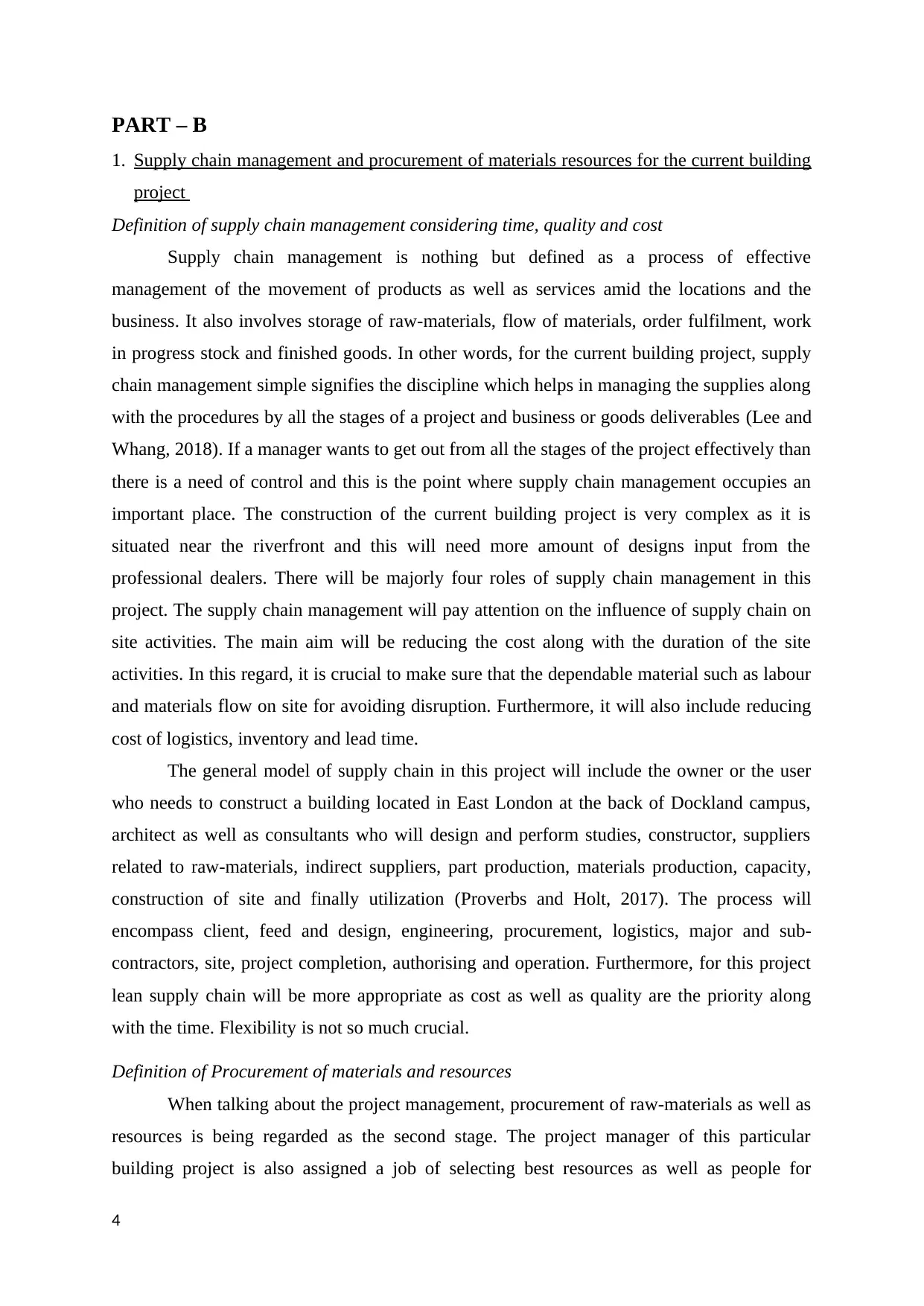
PART – B
1. Supply chain management and procurement of materials resources for the current building
project
Definition of supply chain management considering time, quality and cost
Supply chain management is nothing but defined as a process of effective
management of the movement of products as well as services amid the locations and the
business. It also involves storage of raw-materials, flow of materials, order fulfilment, work
in progress stock and finished goods. In other words, for the current building project, supply
chain management simple signifies the discipline which helps in managing the supplies along
with the procedures by all the stages of a project and business or goods deliverables (Lee and
Whang, 2018). If a manager wants to get out from all the stages of the project effectively than
there is a need of control and this is the point where supply chain management occupies an
important place. The construction of the current building project is very complex as it is
situated near the riverfront and this will need more amount of designs input from the
professional dealers. There will be majorly four roles of supply chain management in this
project. The supply chain management will pay attention on the influence of supply chain on
site activities. The main aim will be reducing the cost along with the duration of the site
activities. In this regard, it is crucial to make sure that the dependable material such as labour
and materials flow on site for avoiding disruption. Furthermore, it will also include reducing
cost of logistics, inventory and lead time.
The general model of supply chain in this project will include the owner or the user
who needs to construct a building located in East London at the back of Dockland campus,
architect as well as consultants who will design and perform studies, constructor, suppliers
related to raw-materials, indirect suppliers, part production, materials production, capacity,
construction of site and finally utilization (Proverbs and Holt, 2017). The process will
encompass client, feed and design, engineering, procurement, logistics, major and sub-
contractors, site, project completion, authorising and operation. Furthermore, for this project
lean supply chain will be more appropriate as cost as well as quality are the priority along
with the time. Flexibility is not so much crucial.
Definition of Procurement of materials and resources
When talking about the project management, procurement of raw-materials as well as
resources is being regarded as the second stage. The project manager of this particular
building project is also assigned a job of selecting best resources as well as people for
4
1. Supply chain management and procurement of materials resources for the current building
project
Definition of supply chain management considering time, quality and cost
Supply chain management is nothing but defined as a process of effective
management of the movement of products as well as services amid the locations and the
business. It also involves storage of raw-materials, flow of materials, order fulfilment, work
in progress stock and finished goods. In other words, for the current building project, supply
chain management simple signifies the discipline which helps in managing the supplies along
with the procedures by all the stages of a project and business or goods deliverables (Lee and
Whang, 2018). If a manager wants to get out from all the stages of the project effectively than
there is a need of control and this is the point where supply chain management occupies an
important place. The construction of the current building project is very complex as it is
situated near the riverfront and this will need more amount of designs input from the
professional dealers. There will be majorly four roles of supply chain management in this
project. The supply chain management will pay attention on the influence of supply chain on
site activities. The main aim will be reducing the cost along with the duration of the site
activities. In this regard, it is crucial to make sure that the dependable material such as labour
and materials flow on site for avoiding disruption. Furthermore, it will also include reducing
cost of logistics, inventory and lead time.
The general model of supply chain in this project will include the owner or the user
who needs to construct a building located in East London at the back of Dockland campus,
architect as well as consultants who will design and perform studies, constructor, suppliers
related to raw-materials, indirect suppliers, part production, materials production, capacity,
construction of site and finally utilization (Proverbs and Holt, 2017). The process will
encompass client, feed and design, engineering, procurement, logistics, major and sub-
contractors, site, project completion, authorising and operation. Furthermore, for this project
lean supply chain will be more appropriate as cost as well as quality are the priority along
with the time. Flexibility is not so much crucial.
Definition of Procurement of materials and resources
When talking about the project management, procurement of raw-materials as well as
resources is being regarded as the second stage. The project manager of this particular
building project is also assigned a job of selecting best resources as well as people for
4
⊘ This is a preview!⊘
Do you want full access?
Subscribe today to unlock all pages.

Trusted by 1+ million students worldwide
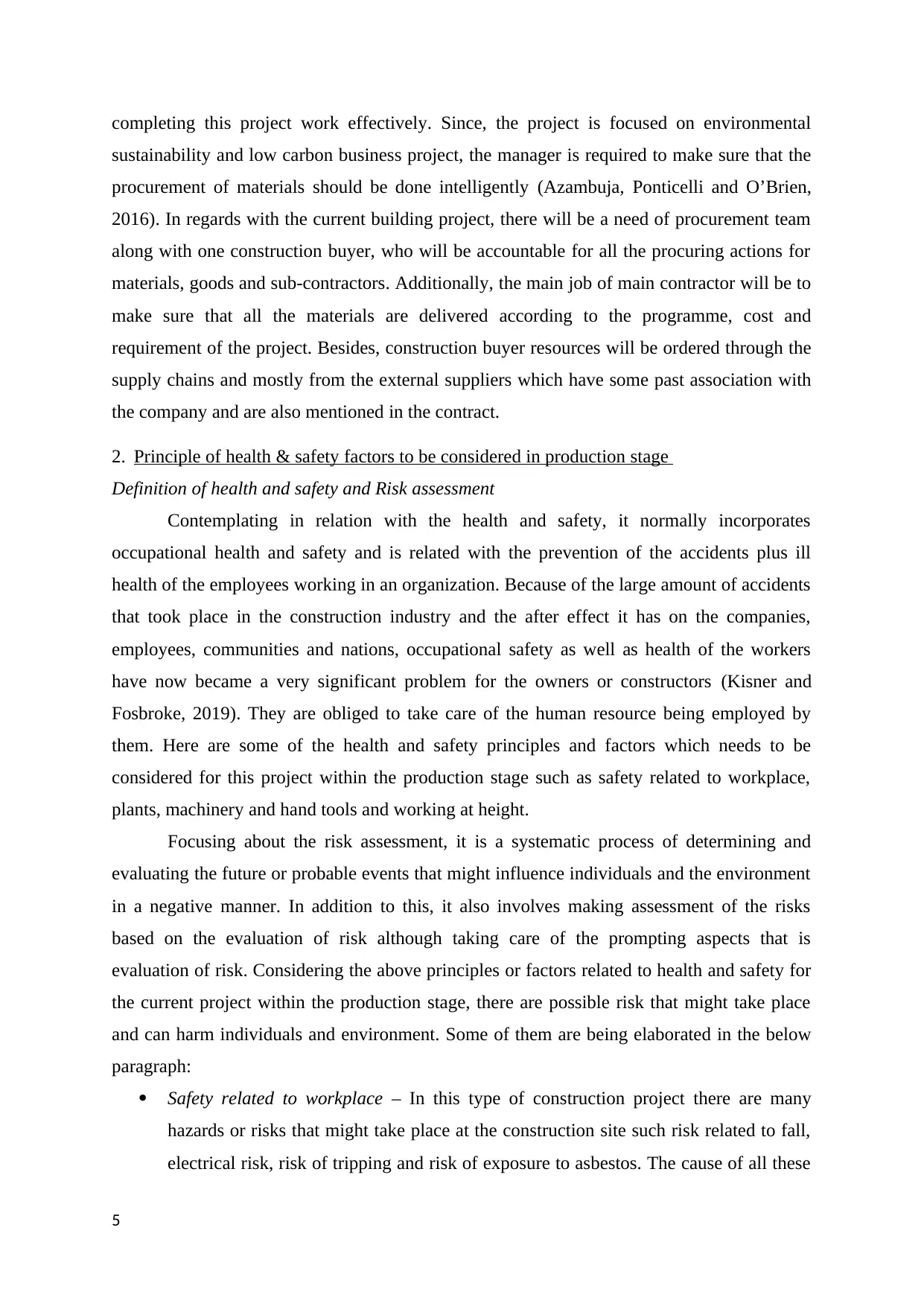
completing this project work effectively. Since, the project is focused on environmental
sustainability and low carbon business project, the manager is required to make sure that the
procurement of materials should be done intelligently (Azambuja, Ponticelli and O’Brien,
2016). In regards with the current building project, there will be a need of procurement team
along with one construction buyer, who will be accountable for all the procuring actions for
materials, goods and sub-contractors. Additionally, the main job of main contractor will be to
make sure that all the materials are delivered according to the programme, cost and
requirement of the project. Besides, construction buyer resources will be ordered through the
supply chains and mostly from the external suppliers which have some past association with
the company and are also mentioned in the contract.
2. Principle of health & safety factors to be considered in production stage
Definition of health and safety and Risk assessment
Contemplating in relation with the health and safety, it normally incorporates
occupational health and safety and is related with the prevention of the accidents plus ill
health of the employees working in an organization. Because of the large amount of accidents
that took place in the construction industry and the after effect it has on the companies,
employees, communities and nations, occupational safety as well as health of the workers
have now became a very significant problem for the owners or constructors (Kisner and
Fosbroke, 2019). They are obliged to take care of the human resource being employed by
them. Here are some of the health and safety principles and factors which needs to be
considered for this project within the production stage such as safety related to workplace,
plants, machinery and hand tools and working at height.
Focusing about the risk assessment, it is a systematic process of determining and
evaluating the future or probable events that might influence individuals and the environment
in a negative manner. In addition to this, it also involves making assessment of the risks
based on the evaluation of risk although taking care of the prompting aspects that is
evaluation of risk. Considering the above principles or factors related to health and safety for
the current project within the production stage, there are possible risk that might take place
and can harm individuals and environment. Some of them are being elaborated in the below
paragraph:
Safety related to workplace – In this type of construction project there are many
hazards or risks that might take place at the construction site such risk related to fall,
electrical risk, risk of tripping and risk of exposure to asbestos. The cause of all these
5
sustainability and low carbon business project, the manager is required to make sure that the
procurement of materials should be done intelligently (Azambuja, Ponticelli and O’Brien,
2016). In regards with the current building project, there will be a need of procurement team
along with one construction buyer, who will be accountable for all the procuring actions for
materials, goods and sub-contractors. Additionally, the main job of main contractor will be to
make sure that all the materials are delivered according to the programme, cost and
requirement of the project. Besides, construction buyer resources will be ordered through the
supply chains and mostly from the external suppliers which have some past association with
the company and are also mentioned in the contract.
2. Principle of health & safety factors to be considered in production stage
Definition of health and safety and Risk assessment
Contemplating in relation with the health and safety, it normally incorporates
occupational health and safety and is related with the prevention of the accidents plus ill
health of the employees working in an organization. Because of the large amount of accidents
that took place in the construction industry and the after effect it has on the companies,
employees, communities and nations, occupational safety as well as health of the workers
have now became a very significant problem for the owners or constructors (Kisner and
Fosbroke, 2019). They are obliged to take care of the human resource being employed by
them. Here are some of the health and safety principles and factors which needs to be
considered for this project within the production stage such as safety related to workplace,
plants, machinery and hand tools and working at height.
Focusing about the risk assessment, it is a systematic process of determining and
evaluating the future or probable events that might influence individuals and the environment
in a negative manner. In addition to this, it also involves making assessment of the risks
based on the evaluation of risk although taking care of the prompting aspects that is
evaluation of risk. Considering the above principles or factors related to health and safety for
the current project within the production stage, there are possible risk that might take place
and can harm individuals and environment. Some of them are being elaborated in the below
paragraph:
Safety related to workplace – In this type of construction project there are many
hazards or risks that might take place at the construction site such risk related to fall,
electrical risk, risk of tripping and risk of exposure to asbestos. The cause of all these
5
Paraphrase This Document
Need a fresh take? Get an instant paraphrase of this document with our AI Paraphraser
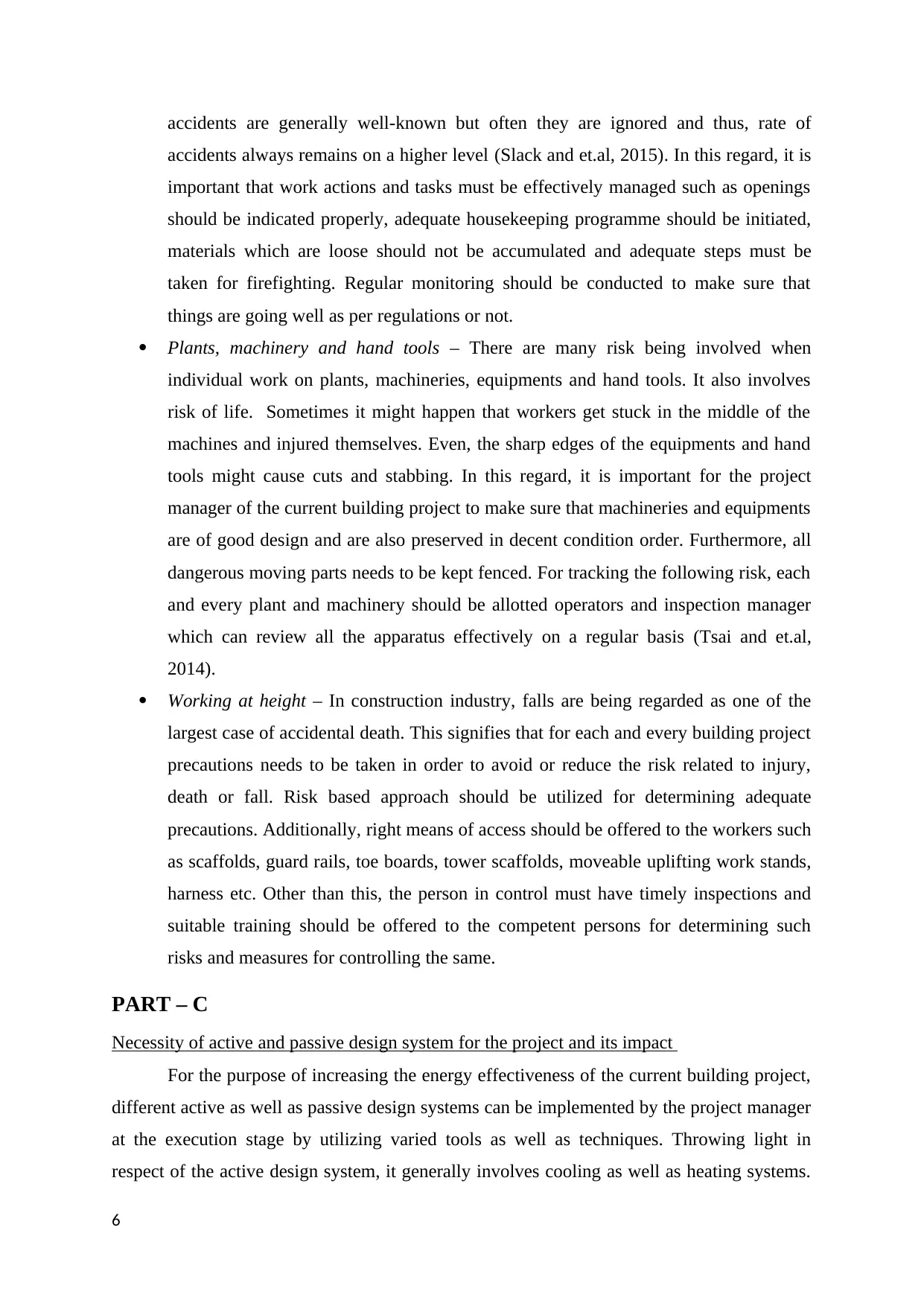
accidents are generally well-known but often they are ignored and thus, rate of
accidents always remains on a higher level (Slack and et.al, 2015). In this regard, it is
important that work actions and tasks must be effectively managed such as openings
should be indicated properly, adequate housekeeping programme should be initiated,
materials which are loose should not be accumulated and adequate steps must be
taken for firefighting. Regular monitoring should be conducted to make sure that
things are going well as per regulations or not.
Plants, machinery and hand tools – There are many risk being involved when
individual work on plants, machineries, equipments and hand tools. It also involves
risk of life. Sometimes it might happen that workers get stuck in the middle of the
machines and injured themselves. Even, the sharp edges of the equipments and hand
tools might cause cuts and stabbing. In this regard, it is important for the project
manager of the current building project to make sure that machineries and equipments
are of good design and are also preserved in decent condition order. Furthermore, all
dangerous moving parts needs to be kept fenced. For tracking the following risk, each
and every plant and machinery should be allotted operators and inspection manager
which can review all the apparatus effectively on a regular basis (Tsai and et.al,
2014).
Working at height – In construction industry, falls are being regarded as one of the
largest case of accidental death. This signifies that for each and every building project
precautions needs to be taken in order to avoid or reduce the risk related to injury,
death or fall. Risk based approach should be utilized for determining adequate
precautions. Additionally, right means of access should be offered to the workers such
as scaffolds, guard rails, toe boards, tower scaffolds, moveable uplifting work stands,
harness etc. Other than this, the person in control must have timely inspections and
suitable training should be offered to the competent persons for determining such
risks and measures for controlling the same.
PART – C
Necessity of active and passive design system for the project and its impact
For the purpose of increasing the energy effectiveness of the current building project,
different active as well as passive design systems can be implemented by the project manager
at the execution stage by utilizing varied tools as well as techniques. Throwing light in
respect of the active design system, it generally involves cooling as well as heating systems.
6
accidents always remains on a higher level (Slack and et.al, 2015). In this regard, it is
important that work actions and tasks must be effectively managed such as openings
should be indicated properly, adequate housekeeping programme should be initiated,
materials which are loose should not be accumulated and adequate steps must be
taken for firefighting. Regular monitoring should be conducted to make sure that
things are going well as per regulations or not.
Plants, machinery and hand tools – There are many risk being involved when
individual work on plants, machineries, equipments and hand tools. It also involves
risk of life. Sometimes it might happen that workers get stuck in the middle of the
machines and injured themselves. Even, the sharp edges of the equipments and hand
tools might cause cuts and stabbing. In this regard, it is important for the project
manager of the current building project to make sure that machineries and equipments
are of good design and are also preserved in decent condition order. Furthermore, all
dangerous moving parts needs to be kept fenced. For tracking the following risk, each
and every plant and machinery should be allotted operators and inspection manager
which can review all the apparatus effectively on a regular basis (Tsai and et.al,
2014).
Working at height – In construction industry, falls are being regarded as one of the
largest case of accidental death. This signifies that for each and every building project
precautions needs to be taken in order to avoid or reduce the risk related to injury,
death or fall. Risk based approach should be utilized for determining adequate
precautions. Additionally, right means of access should be offered to the workers such
as scaffolds, guard rails, toe boards, tower scaffolds, moveable uplifting work stands,
harness etc. Other than this, the person in control must have timely inspections and
suitable training should be offered to the competent persons for determining such
risks and measures for controlling the same.
PART – C
Necessity of active and passive design system for the project and its impact
For the purpose of increasing the energy effectiveness of the current building project,
different active as well as passive design systems can be implemented by the project manager
at the execution stage by utilizing varied tools as well as techniques. Throwing light in
respect of the active design system, it generally involves cooling as well as heating systems.
6
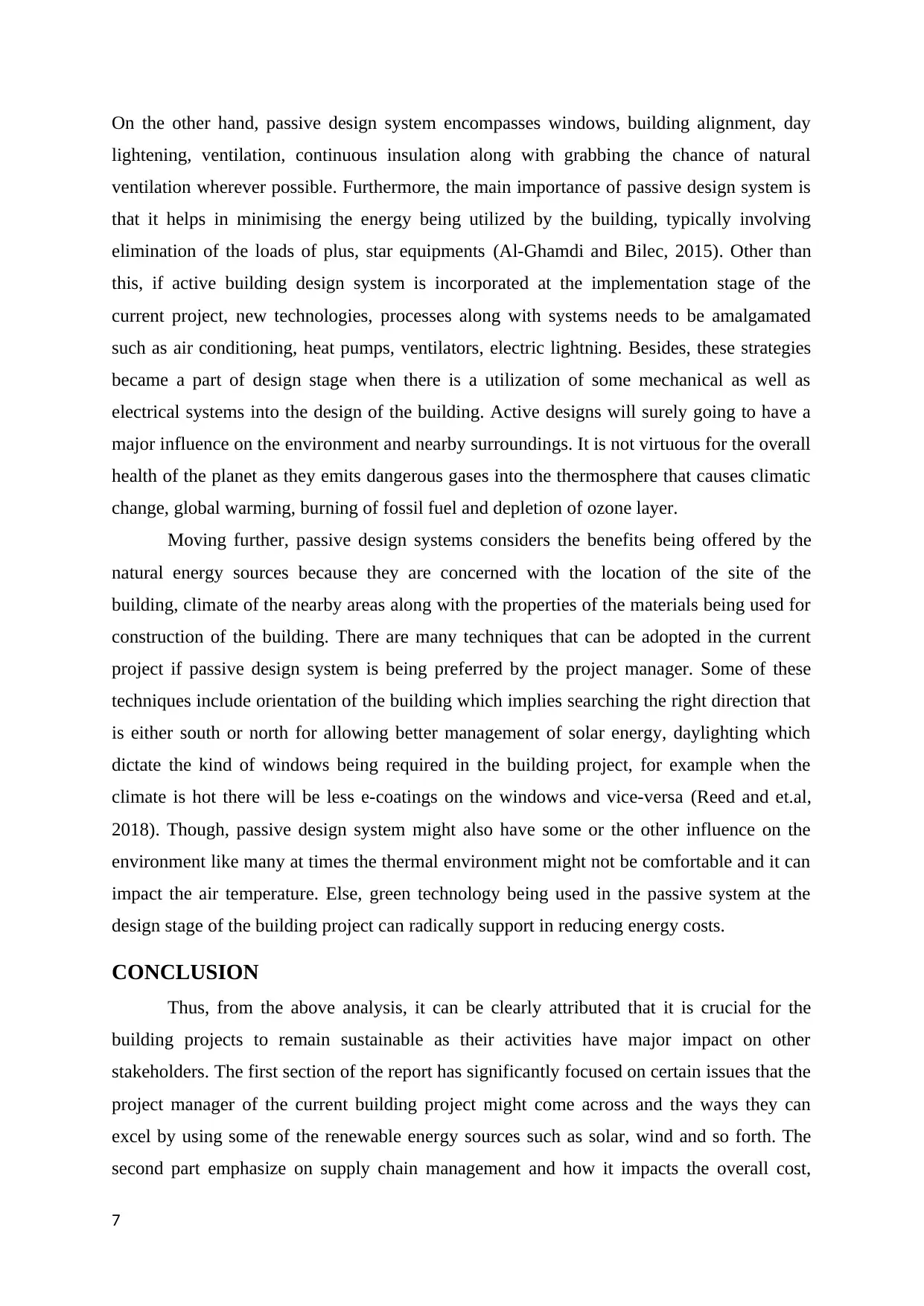
On the other hand, passive design system encompasses windows, building alignment, day
lightening, ventilation, continuous insulation along with grabbing the chance of natural
ventilation wherever possible. Furthermore, the main importance of passive design system is
that it helps in minimising the energy being utilized by the building, typically involving
elimination of the loads of plus, star equipments (Al-Ghamdi and Bilec, 2015). Other than
this, if active building design system is incorporated at the implementation stage of the
current project, new technologies, processes along with systems needs to be amalgamated
such as air conditioning, heat pumps, ventilators, electric lightning. Besides, these strategies
became a part of design stage when there is a utilization of some mechanical as well as
electrical systems into the design of the building. Active designs will surely going to have a
major influence on the environment and nearby surroundings. It is not virtuous for the overall
health of the planet as they emits dangerous gases into the thermosphere that causes climatic
change, global warming, burning of fossil fuel and depletion of ozone layer.
Moving further, passive design systems considers the benefits being offered by the
natural energy sources because they are concerned with the location of the site of the
building, climate of the nearby areas along with the properties of the materials being used for
construction of the building. There are many techniques that can be adopted in the current
project if passive design system is being preferred by the project manager. Some of these
techniques include orientation of the building which implies searching the right direction that
is either south or north for allowing better management of solar energy, daylighting which
dictate the kind of windows being required in the building project, for example when the
climate is hot there will be less e-coatings on the windows and vice-versa (Reed and et.al,
2018). Though, passive design system might also have some or the other influence on the
environment like many at times the thermal environment might not be comfortable and it can
impact the air temperature. Else, green technology being used in the passive system at the
design stage of the building project can radically support in reducing energy costs.
CONCLUSION
Thus, from the above analysis, it can be clearly attributed that it is crucial for the
building projects to remain sustainable as their activities have major impact on other
stakeholders. The first section of the report has significantly focused on certain issues that the
project manager of the current building project might come across and the ways they can
excel by using some of the renewable energy sources such as solar, wind and so forth. The
second part emphasize on supply chain management and how it impacts the overall cost,
7
lightening, ventilation, continuous insulation along with grabbing the chance of natural
ventilation wherever possible. Furthermore, the main importance of passive design system is
that it helps in minimising the energy being utilized by the building, typically involving
elimination of the loads of plus, star equipments (Al-Ghamdi and Bilec, 2015). Other than
this, if active building design system is incorporated at the implementation stage of the
current project, new technologies, processes along with systems needs to be amalgamated
such as air conditioning, heat pumps, ventilators, electric lightning. Besides, these strategies
became a part of design stage when there is a utilization of some mechanical as well as
electrical systems into the design of the building. Active designs will surely going to have a
major influence on the environment and nearby surroundings. It is not virtuous for the overall
health of the planet as they emits dangerous gases into the thermosphere that causes climatic
change, global warming, burning of fossil fuel and depletion of ozone layer.
Moving further, passive design systems considers the benefits being offered by the
natural energy sources because they are concerned with the location of the site of the
building, climate of the nearby areas along with the properties of the materials being used for
construction of the building. There are many techniques that can be adopted in the current
project if passive design system is being preferred by the project manager. Some of these
techniques include orientation of the building which implies searching the right direction that
is either south or north for allowing better management of solar energy, daylighting which
dictate the kind of windows being required in the building project, for example when the
climate is hot there will be less e-coatings on the windows and vice-versa (Reed and et.al,
2018). Though, passive design system might also have some or the other influence on the
environment like many at times the thermal environment might not be comfortable and it can
impact the air temperature. Else, green technology being used in the passive system at the
design stage of the building project can radically support in reducing energy costs.
CONCLUSION
Thus, from the above analysis, it can be clearly attributed that it is crucial for the
building projects to remain sustainable as their activities have major impact on other
stakeholders. The first section of the report has significantly focused on certain issues that the
project manager of the current building project might come across and the ways they can
excel by using some of the renewable energy sources such as solar, wind and so forth. The
second part emphasize on supply chain management and how it impacts the overall cost,
7
⊘ This is a preview!⊘
Do you want full access?
Subscribe today to unlock all pages.

Trusted by 1+ million students worldwide

quality and time of the project. The further section of the report elaborated all the risk and
principles of health and safety within the production stage. If all this breakdown is considered
by the project manager, the project will be a great success.
8
principles of health and safety within the production stage. If all this breakdown is considered
by the project manager, the project will be a great success.
8
Paraphrase This Document
Need a fresh take? Get an instant paraphrase of this document with our AI Paraphraser
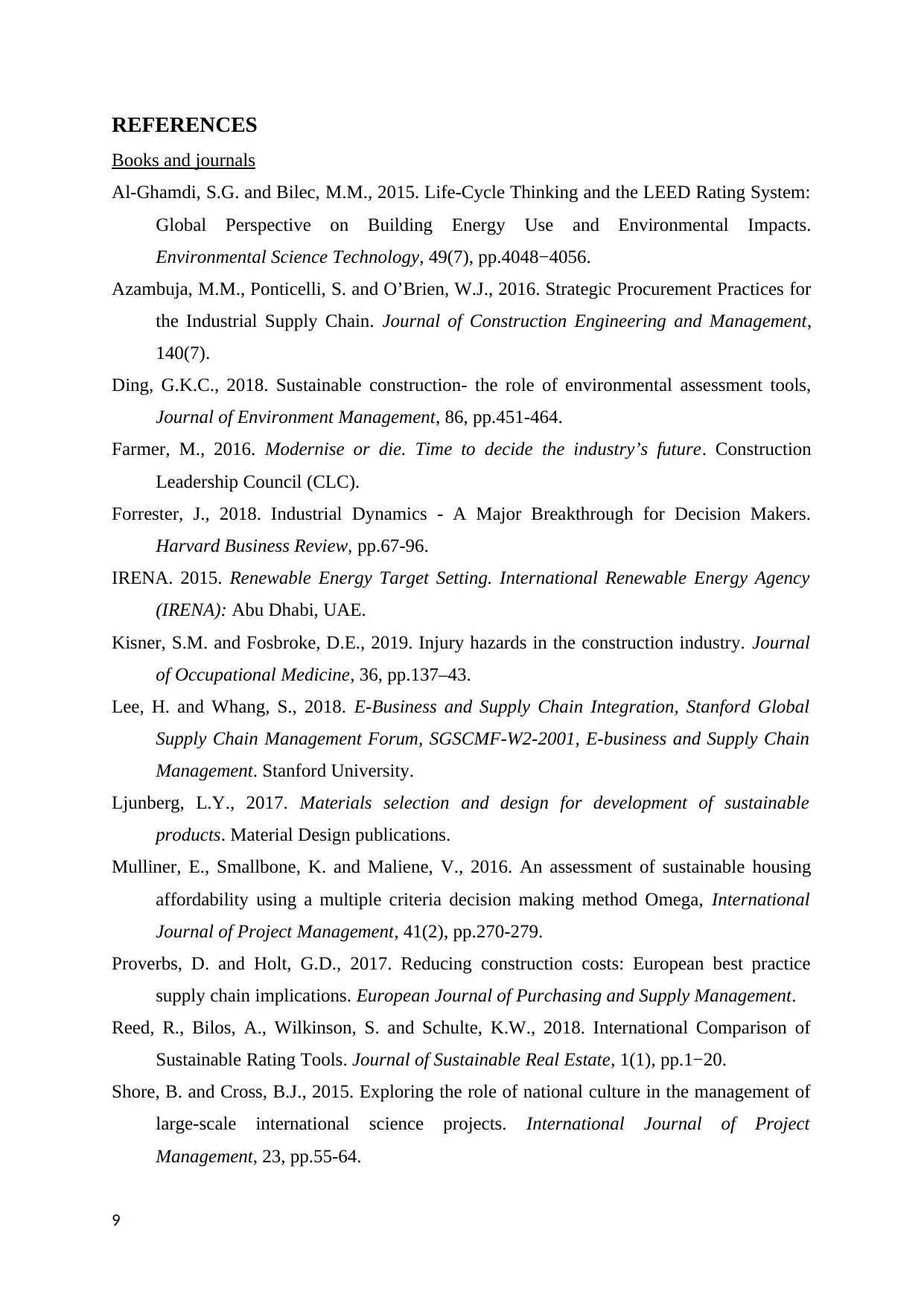
REFERENCES
Books and journals
Al-Ghamdi, S.G. and Bilec, M.M., 2015. Life-Cycle Thinking and the LEED Rating System:
Global Perspective on Building Energy Use and Environmental Impacts.
Environmental Science Technology, 49(7), pp.4048−4056.
Azambuja, M.M., Ponticelli, S. and O’Brien, W.J., 2016. Strategic Procurement Practices for
the Industrial Supply Chain. Journal of Construction Engineering and Management,
140(7).
Ding, G.K.C., 2018. Sustainable construction- the role of environmental assessment tools,
Journal of Environment Management, 86, pp.451-464.
Farmer, M., 2016. Modernise or die. Time to decide the industry’s future. Construction
Leadership Council (CLC).
Forrester, J., 2018. Industrial Dynamics - A Major Breakthrough for Decision Makers.
Harvard Business Review, pp.67-96.
IRENA. 2015. Renewable Energy Target Setting. International Renewable Energy Agency
(IRENA): Abu Dhabi, UAE.
Kisner, S.M. and Fosbroke, D.E., 2019. Injury hazards in the construction industry. Journal
of Occupational Medicine, 36, pp.137–43.
Lee, H. and Whang, S., 2018. E-Business and Supply Chain Integration, Stanford Global
Supply Chain Management Forum, SGSCMF-W2-2001, E-business and Supply Chain
Management. Stanford University.
Ljunberg, L.Y., 2017. Materials selection and design for development of sustainable
products. Material Design publications.
Mulliner, E., Smallbone, K. and Maliene, V., 2016. An assessment of sustainable housing
affordability using a multiple criteria decision making method Omega, International
Journal of Project Management, 41(2), pp.270-279.
Proverbs, D. and Holt, G.D., 2017. Reducing construction costs: European best practice
supply chain implications. European Journal of Purchasing and Supply Management.
Reed, R., Bilos, A., Wilkinson, S. and Schulte, K.W., 2018. International Comparison of
Sustainable Rating Tools. Journal of Sustainable Real Estate, 1(1), pp.1−20.
Shore, B. and Cross, B.J., 2015. Exploring the role of national culture in the management of
large-scale international science projects. International Journal of Project
Management, 23, pp.55-64.
9
Books and journals
Al-Ghamdi, S.G. and Bilec, M.M., 2015. Life-Cycle Thinking and the LEED Rating System:
Global Perspective on Building Energy Use and Environmental Impacts.
Environmental Science Technology, 49(7), pp.4048−4056.
Azambuja, M.M., Ponticelli, S. and O’Brien, W.J., 2016. Strategic Procurement Practices for
the Industrial Supply Chain. Journal of Construction Engineering and Management,
140(7).
Ding, G.K.C., 2018. Sustainable construction- the role of environmental assessment tools,
Journal of Environment Management, 86, pp.451-464.
Farmer, M., 2016. Modernise or die. Time to decide the industry’s future. Construction
Leadership Council (CLC).
Forrester, J., 2018. Industrial Dynamics - A Major Breakthrough for Decision Makers.
Harvard Business Review, pp.67-96.
IRENA. 2015. Renewable Energy Target Setting. International Renewable Energy Agency
(IRENA): Abu Dhabi, UAE.
Kisner, S.M. and Fosbroke, D.E., 2019. Injury hazards in the construction industry. Journal
of Occupational Medicine, 36, pp.137–43.
Lee, H. and Whang, S., 2018. E-Business and Supply Chain Integration, Stanford Global
Supply Chain Management Forum, SGSCMF-W2-2001, E-business and Supply Chain
Management. Stanford University.
Ljunberg, L.Y., 2017. Materials selection and design for development of sustainable
products. Material Design publications.
Mulliner, E., Smallbone, K. and Maliene, V., 2016. An assessment of sustainable housing
affordability using a multiple criteria decision making method Omega, International
Journal of Project Management, 41(2), pp.270-279.
Proverbs, D. and Holt, G.D., 2017. Reducing construction costs: European best practice
supply chain implications. European Journal of Purchasing and Supply Management.
Reed, R., Bilos, A., Wilkinson, S. and Schulte, K.W., 2018. International Comparison of
Sustainable Rating Tools. Journal of Sustainable Real Estate, 1(1), pp.1−20.
Shore, B. and Cross, B.J., 2015. Exploring the role of national culture in the management of
large-scale international science projects. International Journal of Project
Management, 23, pp.55-64.
9
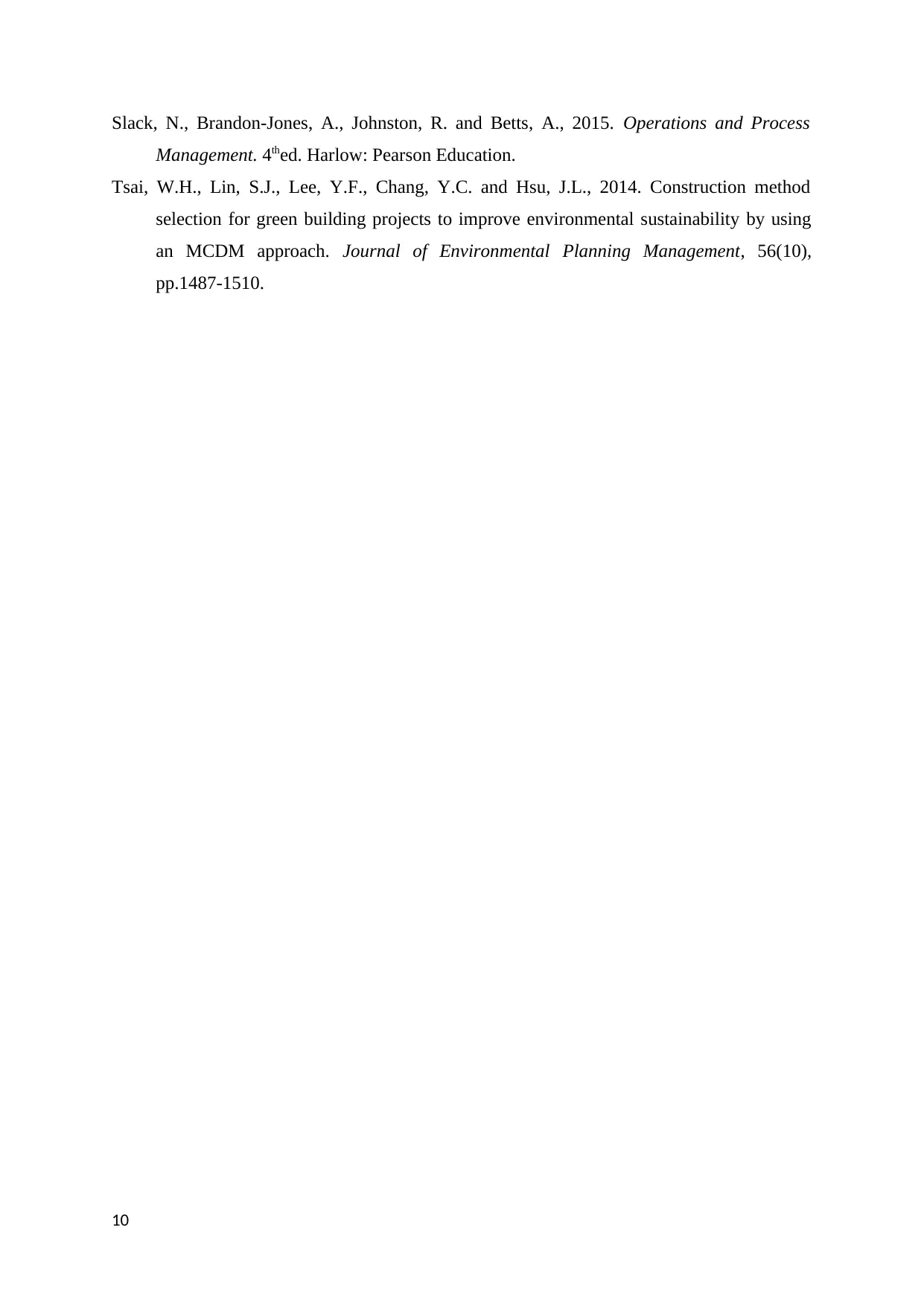
Slack, N., Brandon-Jones, A., Johnston, R. and Betts, A., 2015. Operations and Process
Management. 4thed. Harlow: Pearson Education.
Tsai, W.H., Lin, S.J., Lee, Y.F., Chang, Y.C. and Hsu, J.L., 2014. Construction method
selection for green building projects to improve environmental sustainability by using
an MCDM approach. Journal of Environmental Planning Management, 56(10),
pp.1487-1510.
10
Management. 4thed. Harlow: Pearson Education.
Tsai, W.H., Lin, S.J., Lee, Y.F., Chang, Y.C. and Hsu, J.L., 2014. Construction method
selection for green building projects to improve environmental sustainability by using
an MCDM approach. Journal of Environmental Planning Management, 56(10),
pp.1487-1510.
10
⊘ This is a preview!⊘
Do you want full access?
Subscribe today to unlock all pages.

Trusted by 1+ million students worldwide
1 out of 12
Related Documents
Your All-in-One AI-Powered Toolkit for Academic Success.
+13062052269
info@desklib.com
Available 24*7 on WhatsApp / Email
![[object Object]](/_next/static/media/star-bottom.7253800d.svg)
Unlock your academic potential
Copyright © 2020–2025 A2Z Services. All Rights Reserved. Developed and managed by ZUCOL.





